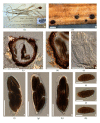A molecular and morphological reassessment of Diademaceae
- PMID: 24526916
- PMCID: PMC3913511
- DOI: 10.1155/2014/675348
A molecular and morphological reassessment of Diademaceae
Abstract
We revisit the family Diademaceae based on available sequence data and morphology. Diademaceae is characterized by ascomata opening with a flat circular lid and fissitunicate, short orbicular frequently cylindrical, pedicellate asci. Ascospores are frequently circular in section but narrowing to one end with three or more transverse septa, without longitudinal septa, and mostly with a thick sheath. In recent treatments Clathrospora, Comoclathris, Diadema, Diademosa, and Graphyllium were placed in the family. Following molecular and morphological study, Clathrospora, Comoclathris, and Diademosa, are excluded from the family and referred to Pleosporaceae. Graphyllium is excluded from Diademaceae, based on hysterothecium-like ascomata with a longitudinal opening, and tentatively placed in Hysteriaceae with uncertainty; species with hysterothecia have now been accommodated in at least five families. The study accepts only Diadema in the family. The status of Diademaceae as a distinct family, based on the ascomata opening by a flat circular lid, is thought to be doubtful. Fresh collections of Diadema are needed for epitypification and to obtain sequence data to establish if this is a well-resolved family.
Figures




References
-
- Shoemaker RA, Babcock CE. Applanodictyosporous pleosporales: Clathrospora, Comoclathris, Graphyllium, Macrospora, and Platysporoides . Canadian Journal of Botany. 1992;70(8):1617–1618.
-
- Hyde KD, Jones EBG, Liu JK, Ariyawansa H, et al. Families of dothideomycetes. Fungal Diversity. 2013;63:1–313.
-
- Zhang Y, Koko TW, Hyde KD. Towards a monograph of Dothideomycetes: studies on Diademaceae . Cryptogamie Mycologie. 2011;32(2):115–126.
Publication types
MeSH terms
Substances
LinkOut - more resources
Full Text Sources
Other Literature Sources
Miscellaneous

